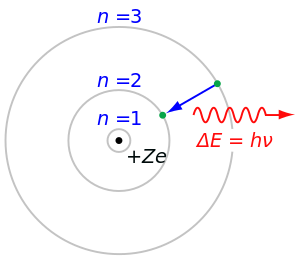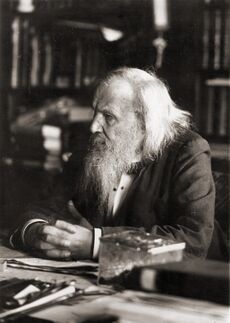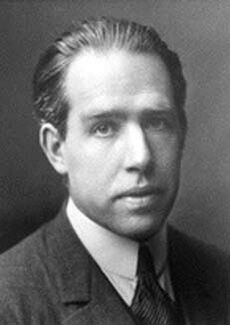رقم ذري

الرقم الذري (Z) هو مصطلح يستخدم في الكيمياء والفيزياء ليمثل عدد البروتونات الموجودة في نواة الذرة. في الذرة المتعادلة الشحنة، يكون عدد الإلكترونات مساو للرقم الذري.
For an ordinary atom which contains protons, neutrons and electrons, the sum of the atomic number Z and the neutron number N gives the atom's atomic mass number A. Since protons and neutrons have approximately the same mass (and the mass of the electrons is negligible for many purposes) and the mass defect of the nucleon binding is always small compared to the nucleon mass, the atomic mass of any atom, when expressed in daltons (making a quantity called the "relative isotopic mass"), is within 1% of the whole number A.
Atoms with the same atomic number but different neutron numbers, and hence different mass numbers, are known as isotopes. A little more than three-quarters of naturally occurring elements exist as a mixture of isotopes (see monoisotopic elements), and the average isotopic mass of an isotopic mixture for an element (called the relative atomic mass) in a defined environment on Earth determines the element's standard atomic weight. Historically, it was these atomic weights of elements (in comparison to hydrogen) that were the quantities measurable by chemists in the 19th century.
The conventional symbol Z comes from the German word Zahl 'number', which, before the modern synthesis of ideas from chemistry and physics, merely denoted an element's numerical place in the periodic table, whose order was then approximately, but not completely, consistent with the order of the elements by atomic weights. Only after 1915, with the suggestion and evidence that this Z number was also the nuclear charge and a physical characteristic of atoms, did the word Atomzahl (and its English equivalent atomic number) come into common use in this context.
The rules above do not always apply to exotic atoms which contain short-lived elementary particles other than protons, neutrons and electrons.
تاريخ
الجدول الدوري ورقم طبيعي لكل عنصر

Loosely speaking, the existence or construction of a periodic table of elements creates an ordering of the elements, and so they can be numbered in order.
ويمثل الرقم الذري عدد العناصر الموجودة في الجدول الدوري. حينما قام مندليف بترتيب العناصرالكيميائية المعروفة طبقا لتماثلها في الخواص الكيميائية لوحظ أن ترتيبها طبقا للكتلة الذرية قد أدى لحدوث بعض الاختلافات. اليود والتيلوريم ، لو تم ترتيبه طبقا للكتلة الذرية فسيكون مكانهم خطأ، و لكن عند ترتيبهم طبقا للرقم الذري أدى ذلك لتطابق خواصهم الكيميائية مع الترتيب. وقد لوحظ أن رقم الكتلة يتناسب تقريبا مع كتلة الذرة، و لكن ظهور بعض الاختلافات قد عكس وجود ارتباط لبعض الخواص الأخرى غير الكتلة.
وقد تم تفسير هذا الانحراف أخيرا بواسطة هنري موزلي في عام 1913. فقد اكتشف موزلي علاقة واضحة بين حيود أشعة إكس لطيف العناصر و المكان الصحيح لهذه العناصر في الجدول الدوري. و قد تم لاحقا توضيح أن الرقم الذري يطابق الشحنة الكهربية في النواة أي بمعنى آخر عدد البروتونات. و هي الشحنة التي تعطي العناصر خواصها الكيميائية، و ليس الكتلة الذرية.
الرقم الذري يتناسب إلى حد كبير مع عدد الكتلة (و يجب عدم الخلط بينهما) و الذي يمثل عدد البروتونات و النيوترونات في نواة الذرة. عدد الكتلة غالبا ما يأتي بعد اسم العنصر، فمثلا كربون-14 (والذي يستخدم لحساب الزمن بالكربون).
نموذج رذرفورد-بور و ڤان دن بروك
In 1911, Ernest Rutherford gave a model of the atom in which a central nucleus held most of the atom's mass and a positive charge which, in units of the electron's charge, was to be approximately equal to half of the atom's atomic weight, expressed in numbers of hydrogen atoms. This central charge would thus be approximately half the atomic weight (though it was almost 25% different from the atomic number of gold (Z = 79, A = 197), the single element from which Rutherford made his guess). Nevertheless, in spite of Rutherford's estimation that gold had a central charge of about 100 (but was element Z = 79 on the periodic table), a month after Rutherford's paper appeared, Antonius van den Broek first formally suggested that the central charge and number of electrons in an atom were exactly equal to its place in the periodic table (also known as element number, atomic number, and symbolized Z). This eventually proved to be the case.
تجربة موزلي 1913

The experimental position improved dramatically after research by Henry Moseley in 1913.[1] Moseley, after discussions with Bohr who was at the same lab (and who had used Van den Broek's hypothesis in his Bohr model of the atom), decided to test Van den Broek's and Bohr's hypothesis directly, by seeing if spectral lines emitted from excited atoms fitted the Bohr theory's postulation that the frequency of the spectral lines be proportional to the square of Z.
To do this, Moseley measured the wavelengths of the innermost photon transitions (K and L lines) produced by the elements from aluminium (Z = 13) to gold (Z = 79) used as a series of movable anodic targets inside an x-ray tube.[2] The square root of the frequency of these photons (x-rays) increased from one target to the next in an arithmetic progression. This led to the conclusion (Moseley's law) that the atomic number does closely correspond (with an offset of one unit for K-lines, in Moseley's work) to the calculated electric charge of the nucleus, i.e. the element number Z. Among other things, Moseley demonstrated that the lanthanide series (from lanthanum to lutetium inclusive) must have 15 members—no fewer and no more—which was far from obvious from known chemistry at that time.
العناصر المفتقدة
After Moseley's death in 1915, the atomic numbers of all known elements from hydrogen to uranium (Z = 92) were examined by his method. There were seven elements (with Z < 92) which were not found and therefore identified as still undiscovered, corresponding to atomic numbers 43, 61, 72, 75, 85, 87 and 91.[3] From 1918 to 1947, all seven of these missing elements were discovered.[4] By this time, the first four transuranium elements had also been discovered, so that the periodic table was complete with no gaps as far as curium (Z = 96).
الپروتون وفكرة الإلكترونات النووية
In 1915, the reason for nuclear charge being quantized in units of Z, which were now recognized to be the same as the element number, was not understood. An old idea called Prout's hypothesis had postulated that the elements were all made of residues (or "protyles") of the lightest element hydrogen, which in the Bohr-Rutherford model had a single electron and a nuclear charge of one. However, as early as 1907, Rutherford and Thomas Royds had shown that alpha particles, which had a charge of +2, were the nuclei of helium atoms, which had a mass four times that of hydrogen, not two times. If Prout's hypothesis were true, something had to be neutralizing some of the charge of the hydrogen nuclei present in the nuclei of heavier atoms.
In 1917, Rutherford succeeded in generating hydrogen nuclei from a nuclear reaction between alpha particles and nitrogen gas,[5] and believed he had proven Prout's law. He called the new heavy nuclear particles protons in 1920 (alternate names being proutons and protyles). It had been immediately apparent from the work of Moseley that the nuclei of heavy atoms have more than twice as much mass as would be expected from their being made of hydrogen nuclei, and thus there was required a hypothesis for the neutralization of the extra protons presumed present in all heavy nuclei. A helium nucleus was presumed to be composed of four protons plus two "nuclear electrons" (electrons bound inside the nucleus) to cancel two of the charges. At the other end of the periodic table, a nucleus of gold with a mass 197 times that of hydrogen was thought to contain 118 nuclear electrons in the nucleus to give it a residual charge of +79, consistent with its atomic number.
اكتشاف النيوترون يصنع Z عدد الپروتونات
All consideration of nuclear electrons ended with James Chadwick's discovery of the neutron in 1932. An atom of gold now was seen as containing 118 neutrons rather than 118 nuclear electrons, and its positive nuclear charge now was realized to come entirely from a content of 79 protons. Since Moseley had previously shown that the atomic number Z of an element equals this positive charge, it was now clear that Z is identical to the number of protons of its nuclei.
الخصائص الكيميائية
Each element has a specific set of chemical properties as a consequence of the number of electrons present in the neutral atom, which is Z (the atomic number). The configuration of these electrons follows from the principles of quantum mechanics. The number of electrons in each element's electron shells, particularly the outermost valence shell, is the primary factor in determining its chemical bonding behavior. Hence, it is the atomic number alone that determines the chemical properties of an element; and it is for this reason that an element can be defined as consisting of any mixture of atoms with a given atomic number.
العناصر الجديدة
The quest for new elements is usually described using atomic numbers. As of قالب:Year, all elements with atomic numbers 1 to 118 have been observed. Synthesis of new elements is accomplished by bombarding target atoms of heavy elements with ions, such that the sum of the atomic numbers of the target and ion elements equals the atomic number of the element being created. In general, the half-life of a nuclide becomes shorter as atomic number increases,[بحاجة لمصدر] though undiscovered nuclides with certain "magic" numbers of protons and neutrons may have relatively longer half-lives and comprise an island of stability.
A hypothetical element composed only of neutrons has also been proposed and would have atomic number 0,[6] but has never been observed.
انظر أيضا
المراجع
- ^ Ordering the Elements in the Periodic Table Archived 4 مارس 2016 at the Wayback Machine, Royal Chemical Society
- ^ Moseley, H.G.J. (1913). "XCIII.The high-frequency spectra of the elements". Philosophical Magazine. Series 6. 26 (156): 1024–1034. doi:10.1080/14786441308635052. Archived (PDF) from the original on 8 July 2023. Retrieved 12 December 2023.
- ^ Eric Scerri, A tale of seven elements, (Oxford University Press 2013) ISBN 978-0-19-539131-2, p.47
- ^ Scerri chaps. 3–9 (one chapter per element)
- ^ Ernest Rutherford | NZHistory.net.nz, New Zealand history online Archived 1 ديسمبر 2012 at the Wayback Machine. Nzhistory.net.nz (19 October 1937). Retrieved on 2011-01-26.
- ^ von Antropoff, A. (1926). "Eine neue Form des periodischen Systems der Elementen". Zeitschrift für Angewandte Chemie (in الألمانية). 39 (23): 722–725. Bibcode:1926AngCh..39..722V. doi:10.1002/ange.19260392303.

